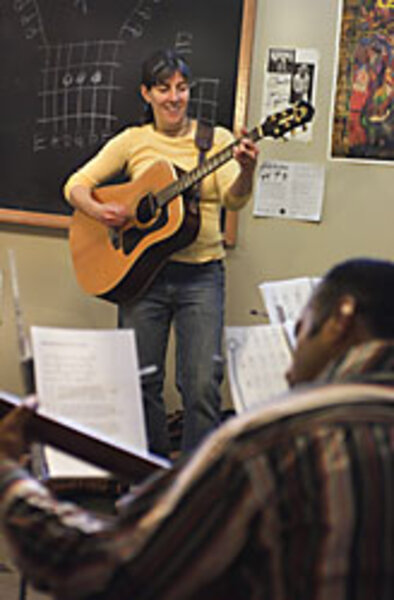Folk flourishes in America's music scene – once again
In the 1960s, it was "Where Have All the Flowers Gone?" Pete Seeger's haunting antiwar anthem. By the early 1980s, it was more like "Where have all the folkies gone?" as keyboards and synthesizers displaced low-tech music.
But folk music is blossoming once again, spurred eight years ago by the release of the movie "O Brother, Where Art Thou" with its roots music soundtrack.
Enrollment at acoustic folk instrument classes is up, the country's oldest guitar maker has had record sales, and attendance is on the rise at festivals.
Folk festivals – there are some 400 of them in the United States – are also reflecting the nation's rapidly changing demographics. Nowadays they are infused with folk music from south of the border, Africa, and Southeast Asia as well as traditional American roots music.
Along with "O Brother, Where Art Thou?" the 1997 rerelease of a major folk music anthology, compiled by Harry Smith, helped inspire a new generation of folksingers. Mr. Smith, a quirky Greenwich Village denizen and chum of Beat poets, was a prodigious collector of folk vinyl back in the 1940s and '50s. A choice selection from his collection was released in 1952 by Folkways Records. It included blues, Cajun, and Appalachian roots music. Its release helped inspire the '60s folk revival. Its rerelease has helped spur yet another.
That revival has flourished in numerous ways. Chicago's Old Town School of Music, founded in 1957 at the onset of the last folk revival, has seen enrollment in acoustic folk instrument classes triple over the past 12 years. Another venerable folk institution, the Swallow Hill Music Association in Denver, has seen enrollment shoot up 25 percent in the past year. And guitar maker C.F. Martin & Company's acoustic instrument sales have broken all records since "O Brother" came out, says company spokesman Dick Boak.
Attendance at the National Folk Festival, which changes venue every three years, nearly tripled from 2005 to 2007, when the festival was in Richmond, Va., and more than doubled during its previous stay in Bangor, Maine. This pattern of growing attendance has been consistent since the 1980s, says Julia Olin, who runs the national festivals for the National Council for the Traditional Arts.
This new folk revival is in some ways more diffuse, more raucous, and more energetic than the last. It is also, arguably, more democratic. Instead of a few big acts recording for major record labels – Bob Dylan, Joan Baez, The Kingston Trio – there are countless folk groups all over the country supporting themselves through their own websites, concerts, and self-produced CDs.
"In the '60s, a few heroes sang the same songs over and over," notes Old Town Music's Bau Graves. "Now we have an army of heroes singing lots of different songs – songs from all over the world."
One thing hasn't changed. It's still a mixture of young and old performers. Mr. Seeger still leads monthly folk music singalongs near his home in Beacon, N.Y. Bruce Springsteen and '60s rocker Country Joe McDonald have jumped on the folk bandwagon. Meanwhile, a younger group of performers has made the switch from rock and punk to folk, playing traditional songs in a loud, fast, revved-up style – what one observer calls "folk music on overdrive."
Folk and punk actually have a lot in common, notes Michael John Simmons, editor of the West Coast-based Fretboard Journal, a glossy quarterly filled with profiles of musicians and lush photos of their instruments. Mr. Simmons points out that folk and punk both have a strong noncommercial bias, a do-it-yourself ethic that eschews major record labels in favor of making your own music to satisfy your own needs.
A few years ago, a group of punk rockers called the Dickel Brothers of Portland, Ore., began playing their old-time banjo, guitar, and ukulele music in the same venues where they once played electrified punk. The only difference was that their youthful fans started forming mosh pits to the tune of "I Dreamed I Saw Joe Hill Last Night."
Younger folkies are following a time-honored folk tradition by putting their own creative stamp on traditional music, just as Woody Guthrie took "Redwing" and turned it into "Union Maid." Using the back-to-the-roots styles of a Mississippi John Hurt or a Brownie McGee, members of this new generation are writing songs that are more relevant to their own times and their own lives.
Former rocker Sean Hoots grew up in the South in a Bible-thumping Pentecostal family. As the leader of the Philadelphia-based band Hoots and Hellmouth he's stayed close to his gospel roots. He performs his own song, "This Hand Is a Mighty Hand," in full-throated gospel style, but the song's message is anything but traditional: The "hand" is not that of an all-powerful God, but refers to any form of oppression that crushes individual will.
In the Southwest, Norteños bands are updating Woody Guthrie's Dust Bowl ballads by singing of the travails of Mexican immigrants. They accompany themselves on guitar and accordion, in the style of traditional Mexican ballads.
Participants in this latest folk music revival are still struggling to explain what it's all about. For songwriter-performer Mr. Hoots it's a chance "to write music for the sake of music," to reconnect with an era before there was something called "the music industry," and before music came to be treated as a product, he says.
Others note the sense of community at a folk performance, the lack of distance between performers and their audience, whether it's Seeger urging everyone to sing along, or, on "This Hand," Hoots and Hellmouth inviting the audience up on stage to be part of the performance.
"They don't do it at you, they do it with you," says Tom Scharf of the Swallow Hill Music Association.
"So much in our culture is mediated through screens big and small," notes Mr. Graves. "What folk music addresses is a thirst for authenticity of experience."





